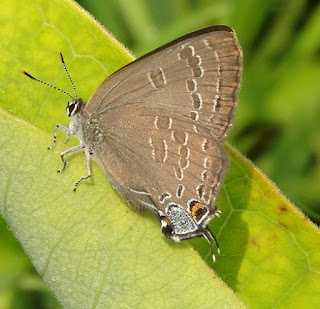I've been making trips down to a Hamilton Conservation Authority property near Dundas lately for work and have had a blast doing some exploring around after the task at hand. The property is an extensive, continuous tract of forest which is part of the Dundas Valley and boasts rich deciduous forest tablelands, deep ravines, wetlands and waterfalls. The stand of Red Oak, White Oak, American Beech, Sugar Maple, Black Cherry and White Pine contains numerous trees approaching 80-120cm DBH and arguably showing characteristics of an old growth stand.
There are tonnes of these crickets bounding across the forest floor. I'm not sure exactly what type of cricket they are, but they sure are plentiful.
This triangular Confused Haploa Moth caught my eye as I huffed and panted my way up a ravine.
Common Wood Nymphs were very active in the shady understory.
This Red Admiral has seen better days.
European Skipper
I chalked this up as a Northern Pearly Eye, based on the keys and resources I'm working with. Hopefully in time I'll be able to tell these apart from Eyed Brown and Appalachian Brown, tips welcome!
I nearly broke my ankle in a gopher hole bounding after this False Crocus Geometer moth. The wingspan on this one was about 10cm, very showy.
The iridescent blue Virginia Chetenucha moth.
I love the call of Gray Catbirds, so menacing and taunting when you're doing a veg plot survey and these guys choose to perch above you and whine away.
There were a few Silver-spotted Skipper and wow were they ever territorial. As I stodd in a milkweed and vetch-rich meadow within a White Pine plantation, these guys were just bombing past my head, seemingly playing chicken.
Eastern Comma
I knew I would find a Monarch, 10,000+ Common Milkweed can't be wrong.
I think this is just a worn/lighter Northern Crescent, kind of more pale than what I normally see.
Again, being new to butterfly ID, I think this is a Hickory Hairstreak based on the arrangement/white edging on the lines and the large bluish patch.
This badass-looking Himmelman's Plume Moth, has some impressive spikes.
Striped Hairstreak with the orange cap on the bluish spot.
Common Yellowthroat were interested in what I was doing poking around in the meadow.
And finally a small orange skipper that wasn't a European. That said, I am only venturing a guess that this is a Delaware.
I finished the morning picking a handful of blackberries and raspberries to top off a bowl of french vanilla ice cream when I got home.


















Nice Pat! Looks like you've got the HX50 keyed in! Butterflies best beware!!
ReplyDelete